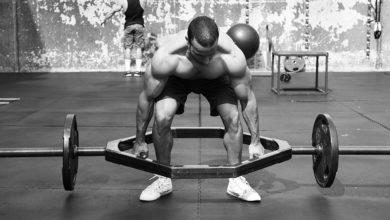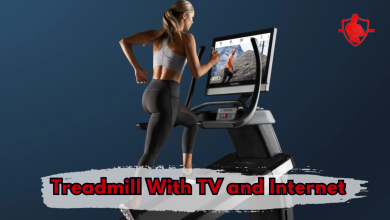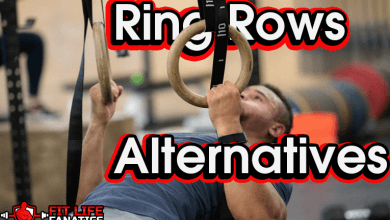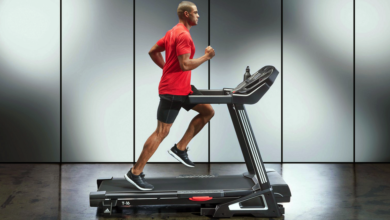The Lat Pulldown vs Seated Row

It’s common for some exercises to have overlapping benefits and secondary muscle recruitment. For instance, every push exercise for the chest will also engage the triceps. It’s unavoidable.
The Lat pulldown and the seated row fall into this category of exercises. Both of these are staples in advanced workout programs that focus on overall back development. But their benefits and target muscles are eerily similar.
Further, both are pull exercises, although performed in different planes (line of pull)
When it comes to a primary muscle group like the back, you’d want to avoid overworking and instead, focus on the most effective option.
The question is, which one of these two would you select, as the primary exercise on back day? That’s what we are going to discuss today.
We have researched extensively on these two exercises and how they fare when pitted against one another in terms of ease of performing, target muscles, potential for poor form, and overall benefits.
Strap in as we decode the Lat Pulldown and the Seated Row.
Lat Pulldown Exercise Quick Overview
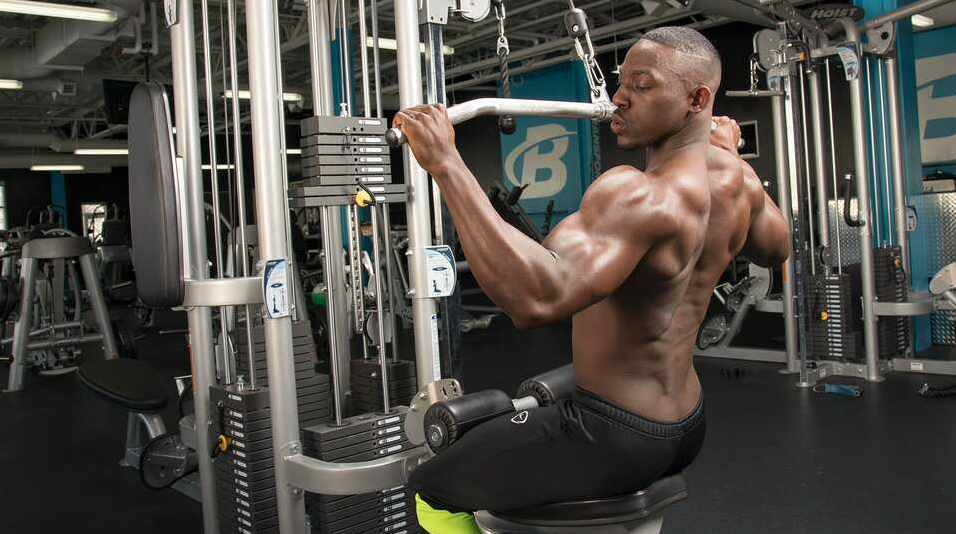
The Lat Pulldown is a terrific exercise for those looking to develop thick and wide back muscles, because it primarily targets the ‘latissimus dorsi’, along with some muscle heads of the upper back.
In case you were unaware, ‘Latissimus Dorsi’ translates into the widest portion of the back. So, if your body currently lacks the V-taper, this is the exercise that you must choose over anything else.
It is often called the ‘Pull-Up’s’ gentler sibling, because it is generally a substitute for the pull-up, for those who cannot perform it, which is a large part of the population.
How to Do The Exercise
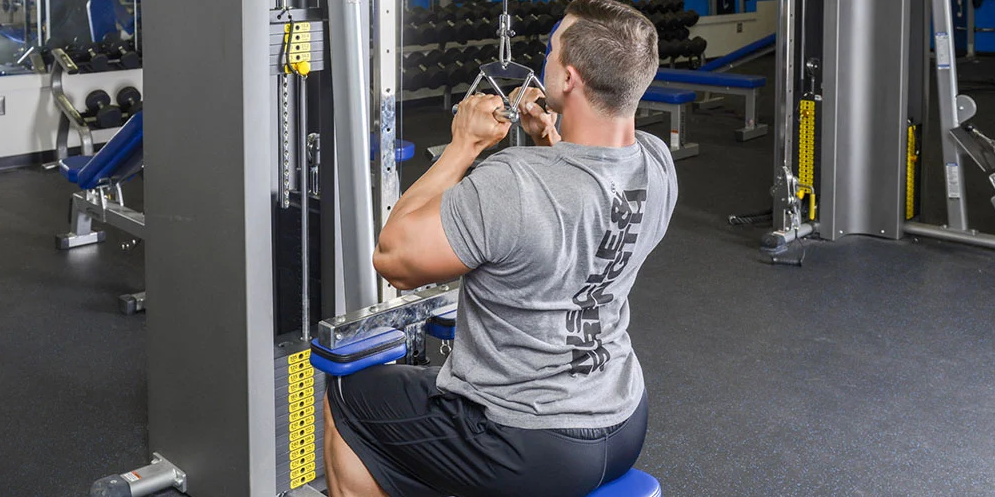
If you take a look around in the gym, you’ll find a lot of people attempting to perform the lat pulldown.
Notice how we mentioned ‘attempting’?
The Lat Pulldown is a deceptive exercise that appears to be reasonably easy. But most people get it horribly wrong.
Here’s how To Do It Right

Sit on the seat with a straight back, upright chest and feet placed flat on the floor.
Adjust the height of the bar as required. You should be able to grab the bar without having to lift your butt off the seat.
If the pull/cable station features a thigh pad, tuck your upper thighs under this to prevent your legs from moving when you pull the weight.
The standard version of the lat pulldown features an overhand grip.
Use a Grip Wider than Your Shoulders

Exhale, brace your core and pull the bar down, trying to maintain a stationary torso through the movement. The bar at its lowest position should be at your chin level. When your elbows are locked, which means that you cannot pull any lower without adjusting your back, you are at the lowest position in the movement.
Pause for a second and slowly let the bar return to the top position. This must be controlled and gradual too. Don’t let the bar go and slam the weight.
That’s one rep. Continue until you hit the desired number of reps.
Muscles Worked By The Lat Pulldown
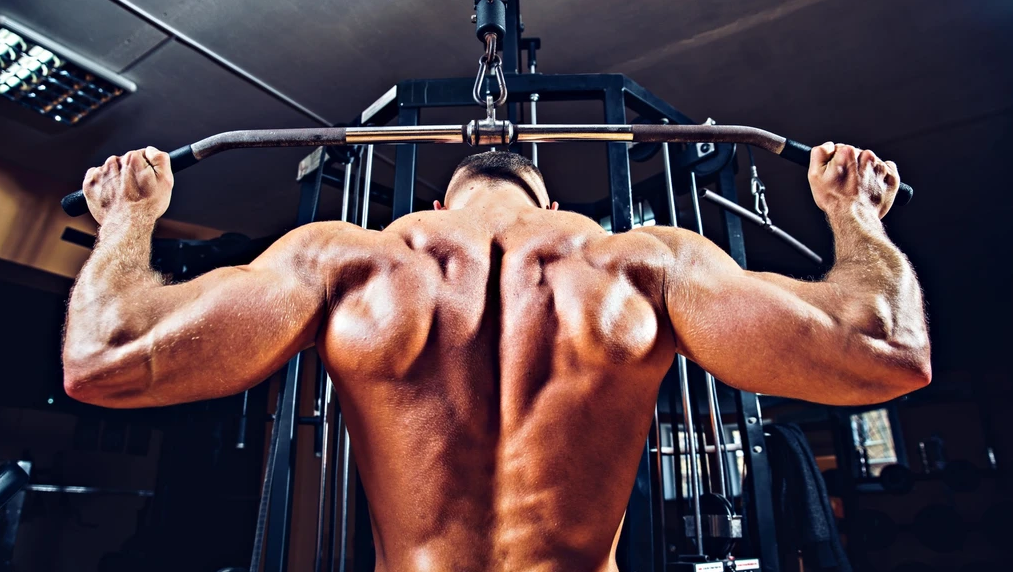
The Lat Pulldown is the second best exercise to target the ‘Latissimus Dorsi’. The first one of course, is the pull up. But there are many advantages to choosing the Lat Pulldown over the pull up.
The Pull-Up is more of a compound move that recruits almost every single muscle in your upper body. But the Lat Pulldown is more of an isolation move for the Latissimus Dorsi.
Latissimus Dorsi

The Latissimus Dorsi is a thin and broad band of muscle tissue that covers the ribs on your back and runs all the way to the waist. Aesthetically, it is one of the most important muscles for overall back development as well as symmetry. But functionally, it is of even more significance since you engage this muscle every time you perform a pull move. Be it lifting a heavy object off the shelf and lowering it down, or swinging your arms while walking, the latissimus is an important muscle.
Other exercises that work the same muscles include t bar rows and low rows.
Rhomboids Major & Minor

At one point during the move, when the bar comes close to your chin, you will engage the Rhomboid Major & Minor, which allow the scapula and the shoulder blades to retract when you pull.
Biceps
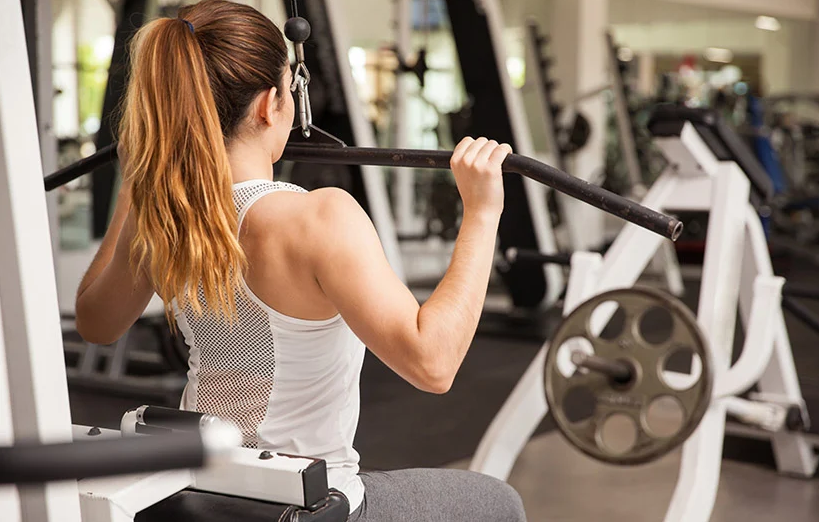
A lot of fitness buffs are unaware that the lat pulldown is a very effective exercise for the biceps. The hypertrophy benefits are almost comparable to the bicep curl in beginners with no training experience.
Other Muscle areas worked by this exercise
- Teres Major & Minor.
- The rotator cuff.
- Lower and Middle traps.
Related Reading; Pendlay Rows: How to, Variations, Benefits, Muscles worked, and Alternative Exercises
Benefits of the Exercise
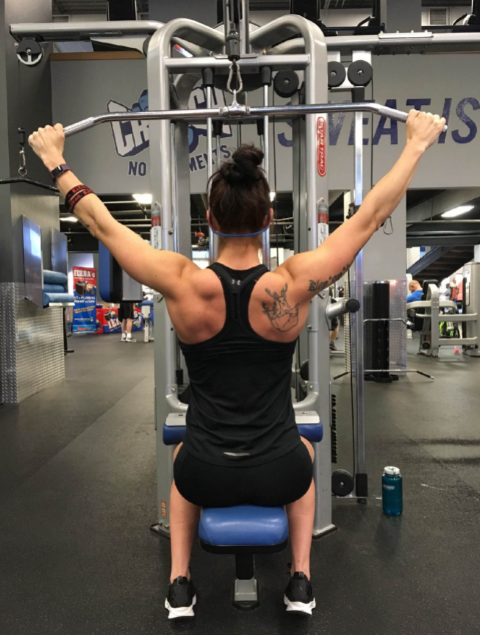
The Lat Pulldown offers many benefits over other similar exercises, including the pull up.
You can start with a light weight and increase it as much as you want to. You are not forced to pull your body weight, as is the case with the pull up.
It’s a terrific isolation exercise, for the Latissimus dorsi. Also, the plane in which you pull the bar is more vertical, which is precisely the direction in which the insertions and connectors of the lats are positioned. This gives your lats a greater range of motion as you pull the weight.
It’s reasonably easy to perform with good form, provided you don’t let your ego get the better of you and try to haul a metric ton of weight.
Tips on How to do It Properly and Mistakes to Avoid
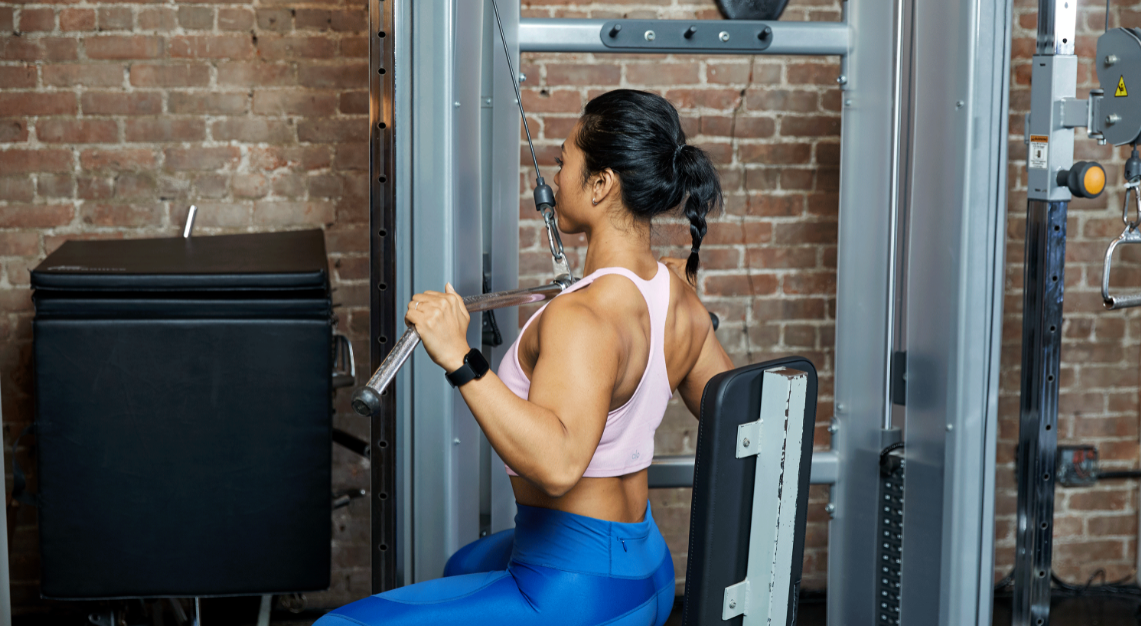
Remember what we said about this exercise being deceptive?
Chances are that you’ll find more people doing this incorrectly, than the right way.
Here’s the kicker. The right way is reasonably easy to learn. It’s not as complex as a front barbell squat or a Clean & Jerk. You are seated. You are pulling the weight. All that you’ve got to ensure is that you don’t swing around wildly.
Tips to Get The Best Out of This Exercise
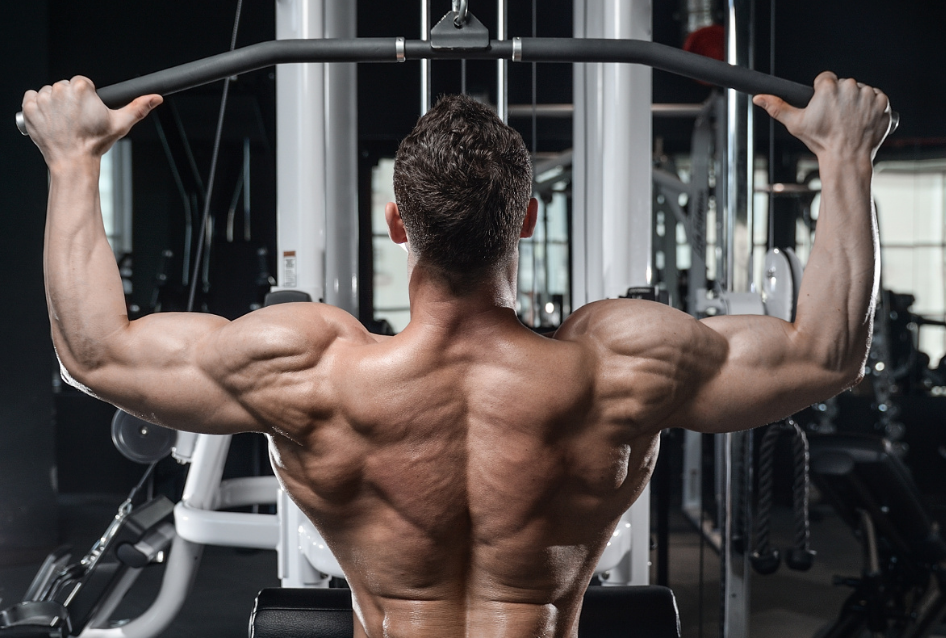
Start light. Everybody who transitions to the Lat pulldown from the Pull-Up feels that they’ve attained Nirvana. The next (il) logical step is to throw a ton of weight and try to pull it with all their might.
Don’t be that guy. Work your way to heavier weight.
Maintain a stable torso. Don’t swing or move backwards as you bring the weight to the chest. If you do, you alter the plane of the pull and recruit a bunch of muscles that have no role to play in the exercise.
Stay seated and keep your feet on the floor at all times.
Focus on the breathing.
Mistakes to Avoid When Doing This Exercise
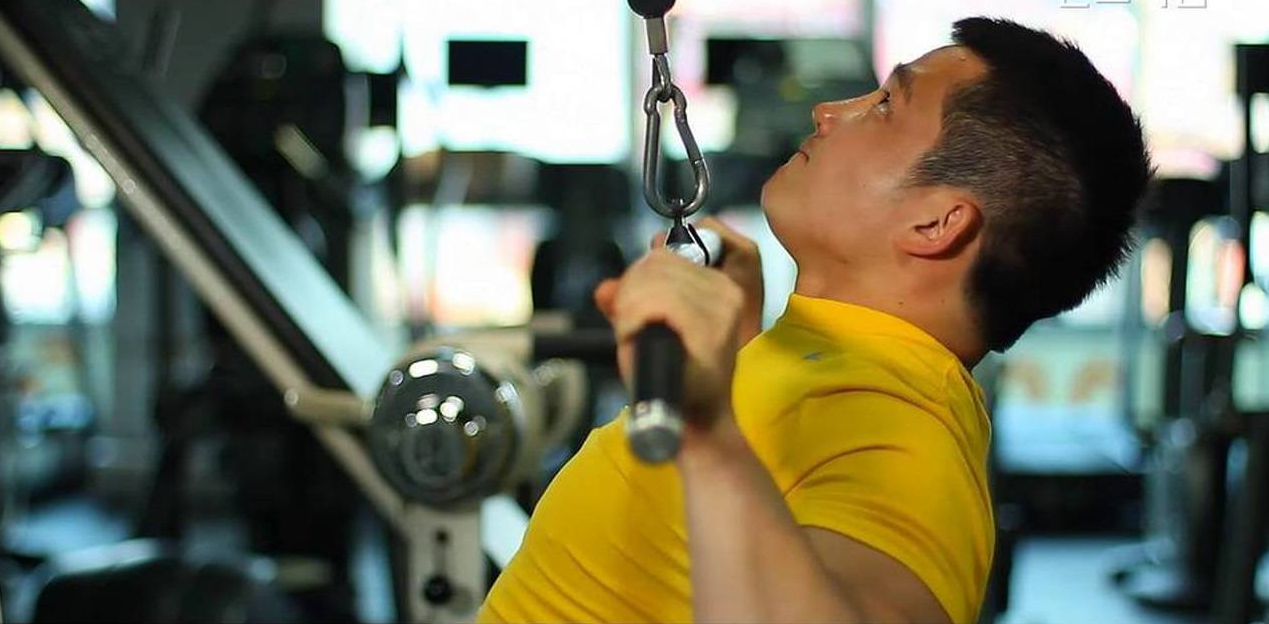
Maintain a neutral spine throughout the exercise. It’s very easy to hyperextend the spine when you move backwards trying to haul weight.
Do not pull the bar behind the neck. Period. Pull it in front, up to chin level only. Not an inch lower than that. Not to the chest, and certainly not to the waist.
Grip the bar slightly wider than shoulders. Not any further. Going any wider than that is not going to broaden the lat. That’s a myth.
Seated Row Exercise Quick Overview
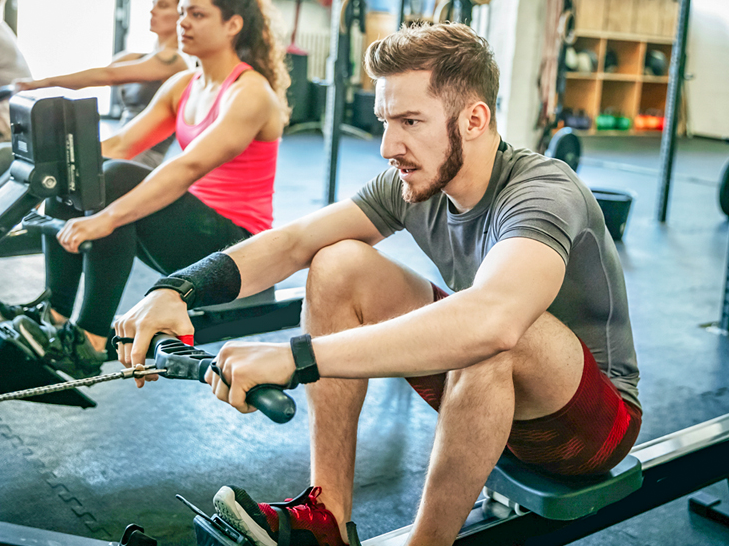
A seated cable row is an upper back and arms exercise, that targets the same muscles as the lat pulldown. There are numerous ways to perform this exercise. But one of the commonest ways is to use a horizontal cable row machine.
One with a seat and a foot rest to keep your feet stable as you pull the cable.
How to Do the Exercise
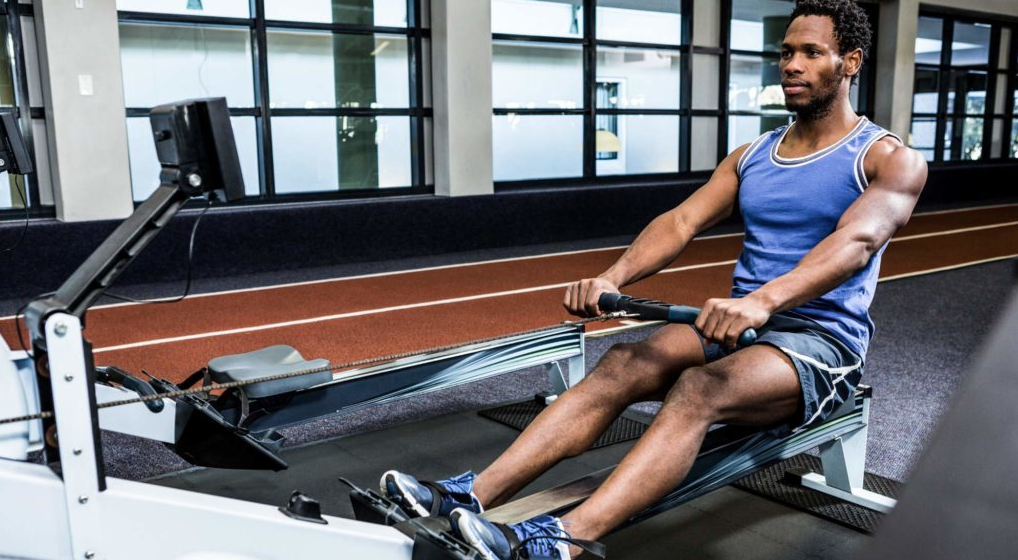
Sit with a flat back and upright chest on the seat. The knees should be bent and the feet should be braced against the footplates so that you cannot lift them up when you pull the weight.
The handle can either be the triangular one or a standard bar.
You need to adjust the seat position so that you have to reach out with your arms extended to grab the handle. But you should not curl your back at this point. The back remains straight.
Brace your core and pull the handle towards your lower abdomen, maintaining a straight back and stationary torso. Now, some amount of torso movement is unavoidable.
You can lean a wee bit when you pull.
But do not overdo it.
When the handle reaches the lower abdomen, pause and squeeze for a second. Then let the handle return to the starting position, in a controlled fashion.
The tension will be maintained all through the move.
That’s one rep. Continue for the desired number of reps.
Muscles Worked By Seated Rows

The seated row is a terrific exercise for the upper back, the mid back, the latissimus dorsi and the arms. But just like the lat pulldown, it is predominantly a latissimus dorsi exercise.
Latissimus dorsi

The key difference here is the plane/direction in which you pull. The lat pulldown is more of a vertical pull, whereas the seated row is a horizontal pull.
They hit the latissimus dorsi in different ways.
Trapezius

The seated row will also engage the muscles of the trapezius. These include the neck muscles, shoulder muscles & the muscles of the upper back.
Biceps & Forearms
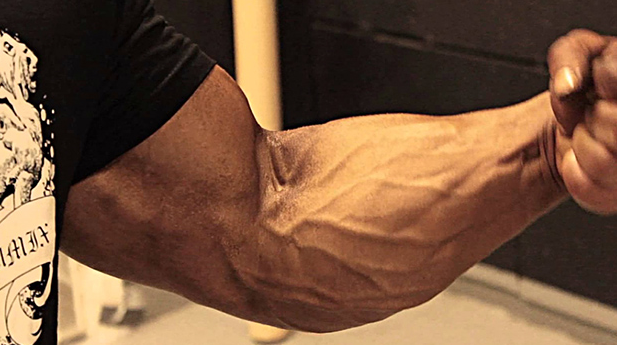
The biceps and the forearms help you stabilize the weight as you pull it towards the body. But it’s not as effective for the biceps as the lat pulldown is.
If you want to target your biceps and forearms then you can try rear delt rows, underhand dumbbell rows, high pulls or upright rows.
Benefits of the Exercise
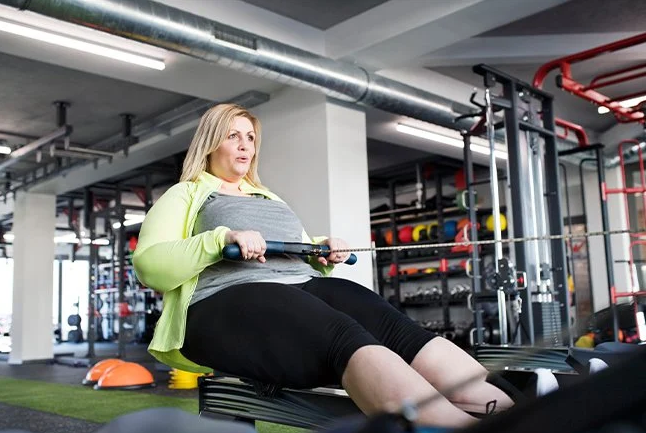
The seated row is a compound exercise. While it primarily targets the Latissimus dorsi, it also engages almost every major muscle group in your upper body, and even some in your lower body if you consider that you use your hamstrings and glutes for balance.
That’s what makes this such a popular exercise with bodybuilders.
Less dependent on form as compared to compound back exercises like the bent over row, or the deadlift. Don’t get us wrong. You still need to nail the exercise to the T.
But there’s a much lower chance that you’ll end up straining your lower back while performing the seated row. Whereas the deadlift is notorious for it and yet, people try to perform it with poor form.
Your muscles are subject to constant tension from the moment you grab that handle, until you let it go.
That’s the beauty of a cable exercise.
Both, the eccentric and concentric movements will fire your muscles.
There are endless variations of the seated row. You can swap handles, alter grips, change the height and switch machines, to name a few. Even a tiny alteration transforms the exercise completely.
Tips on How to Do It Properly and Mistakes to Avoid
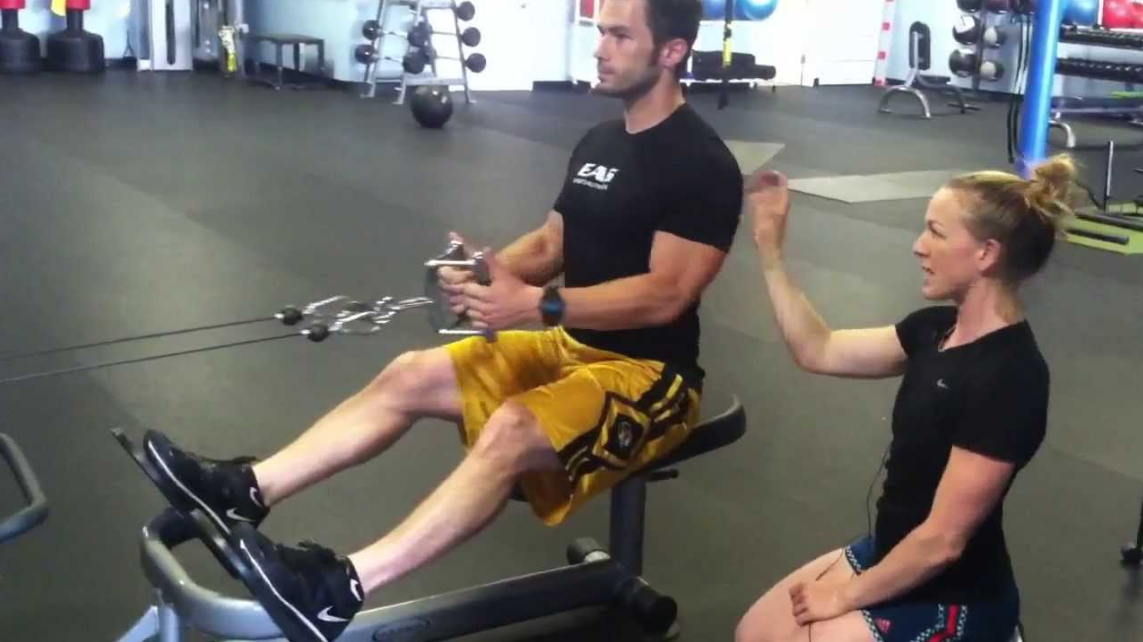
We consider the seated row to be one of the easiest exercises to master and perform. That said, there are some ways to maximize the effectiveness of the move and some pitfalls to be wary of.
Tips to Get the Best Out of This Exercise

Start with a very light weight if you have never done the exercise before. It’s crucial that your adductors and stabilizer muscles get used to staying under constant tension.
This can be achieved even with very little weight. You can readily increase the weight as you get more comfortable handling it.
Focus on your breathing throughout the move.
Learn how to perform the exercise with one grip, before trying a variation.
Complete the range of motion in a slow and steady movement. Do not jerk or swing the cable.
Mistakes to Avoid When Doing This Exercise
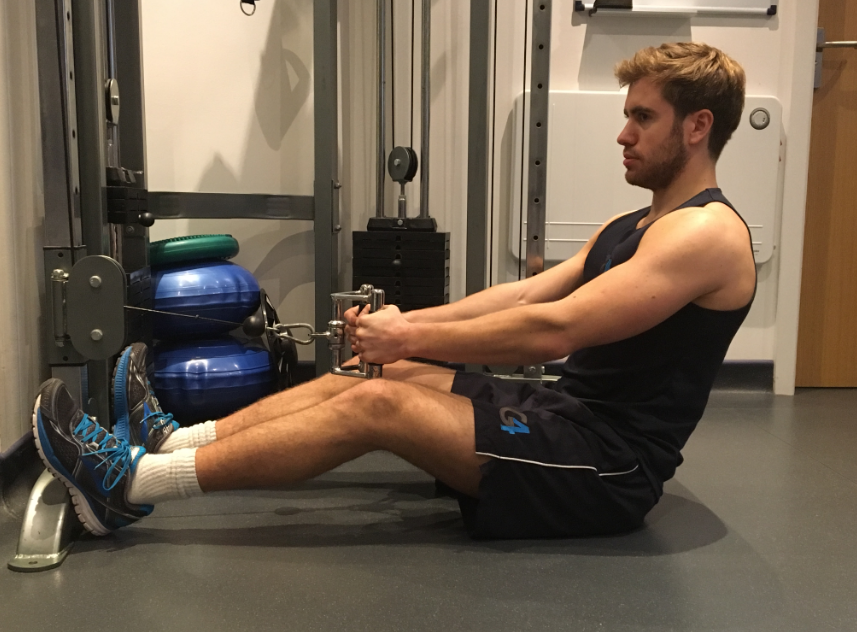
Do not crouch or round your back when you reach out forward extending your arms. The back stays straight and you can hinge at the hips.
Don’t swing the torso back and forth trying to move more weight than you should.
Do the full range of motion. The handles should touch your lower belly at the end position, while your arms should be stretched out in front making you lean forward at the starting position.
Don’t shrug your shoulders or round them.
The elbows should not flare out when you pull the weight. Keep them tucked in, close to your torso.
Bend your knees slightly to prevent a hamstring pull and unwanted stress on the knee caps.
Lat Pulldown Vs Seated Row


All things said and done, here’s a detailed comparison of these two exercises, which should shine some light on which one best suits your goal.
Which Exercise Targets More Muscles?
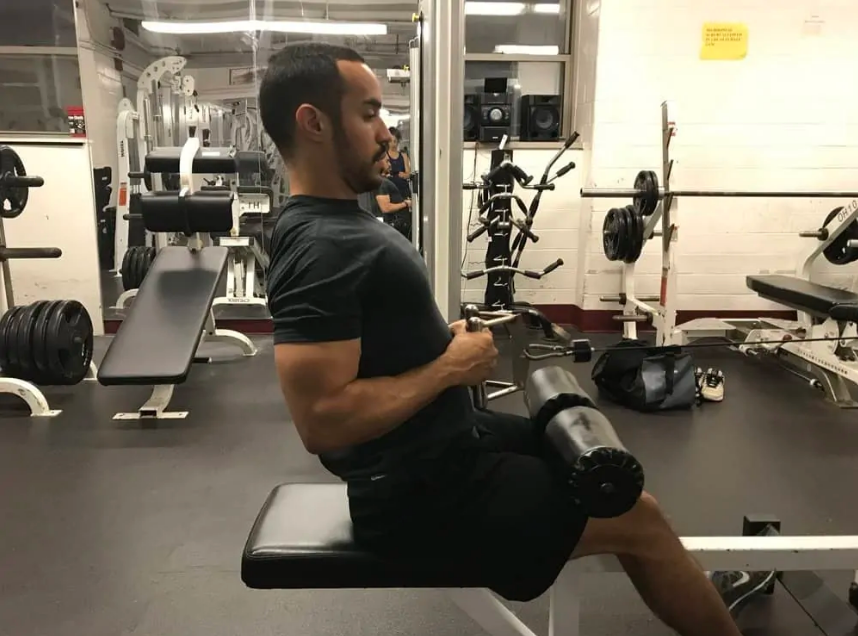
The seated row targets more muscles than the lat pulldown. It’s a compound move that involves the rhomboids, the lats, the arms, the adductors, the glutes and hamstrings.
Which Exercise Is Easier to Do Correctly?
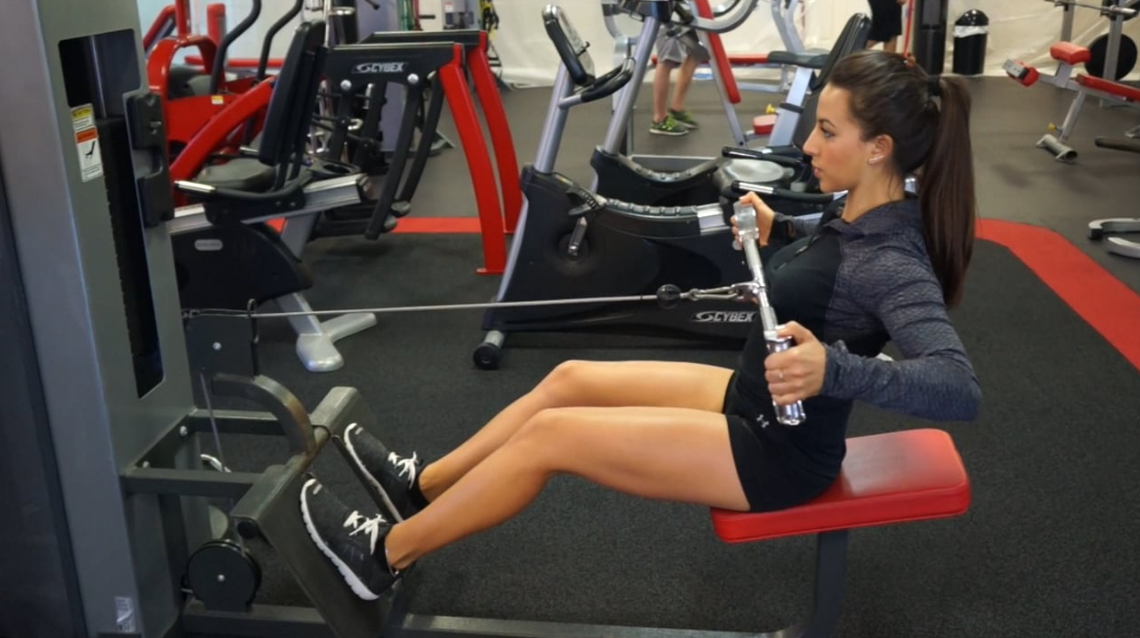
To be fair, both these exercises are easy enough to do correctly. Most of the form issues can be narrowed down to the weight that the person is trying to move.
When you cannot lift the weight comfortably, you start to use other muscles to force through the range of motion.
As long you are not gunning for boasting rights, you should have zero problems with either of these exercises.
Which One Is Better for Upper Body Development?
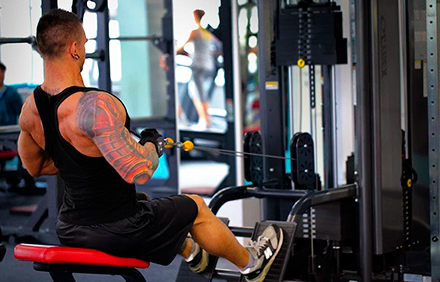
They both are. As we mentioned earlier, the line of pull in both these exercises is very different. So while you are hitting the same primary muscle, you are engaging different muscle fibers.
Also, the seated row recruits more stabilizer muscles than the pulldown.
The pulldown is preferred in hypertrophy programs, while strength-centric programs will use the seated row instead. But if you are looking at developing thick and wide lateral muscles, we would recommend that you use both these exercises.
Which Exercise Is Safer?
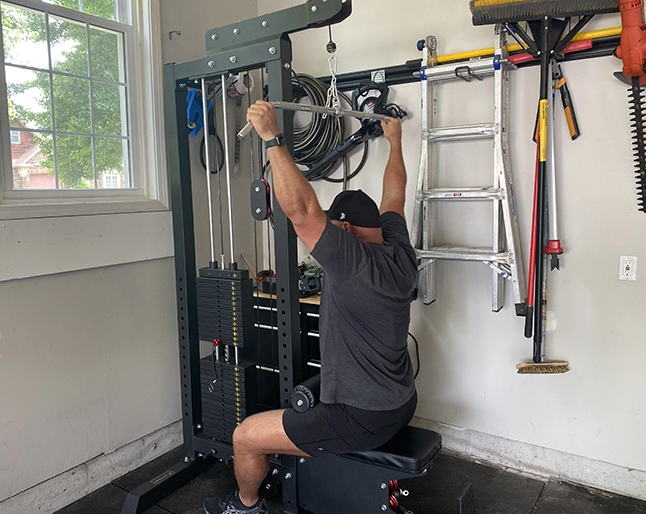
It has to be the lat pulldown.
While the seated row is equally safe, there is a real possibility that you might end up pulling a muscle in the lower back, or shoulders due to poor form.
Which Exercise Is More Suited for Beginners?
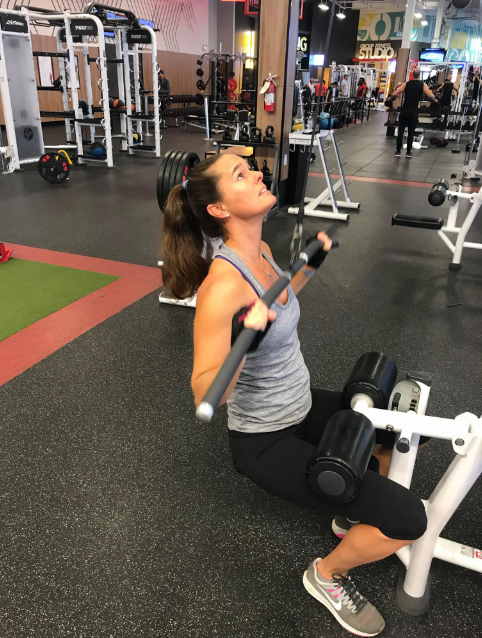
Once again, we veer towards the lat pulldown as being beginner-friendly, as opposed to the seated row. A compound exercise that involves multiple muscles, especially the back and spine, is never recommended to beginners.
Related Readings:
- Biceps Vs Triceps – Everything You Need To Know
- Seated Tricep Press: How To w/ Video Demonstration, Muscles Worked, & Alternative Exercises
- Shocking Muscle Growth Stories that Will Blow Your Mind
- Donkey Calf Raise Alternative Exercises
- Should You Workout 6 Days a Week?
- DIY lat pulldown bar
Resources:
Ben Mayz
Hi there! I'm Ben, main author and chief editor at Fitlifefanatics.com. I have been obsessed with Strength Training and Fitness for 18 years now.
My passion for living a happy fit lifestyle is what made me realize that fitness is what I wanted for my future.
I went on to earn my Masters in Sports Training & Biomechanics.
My passion for Strength training & fitness and my love of helping others is what made me start Fitlifefanatics.
Here, myself, and a team of specialist aim to provide the most accurate, and actionable information possible in hopes to help foster the fitness community forward.
You can learn more about Fitlifefanatics on our About Page
